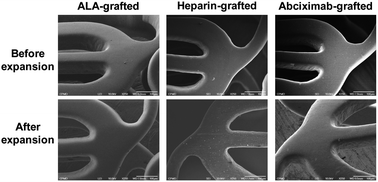Nitrogen-doped TiO2 films as drug-binding matrices for the preparation of drug-eluting stents†
Abstract

* Corresponding authors
a
Center for Functional Nano Fine Chemicals & School of Applied Chemical Engineering, Chonnam National University, Yongbongdong 300, Gwangju, Republic of Korea
E-mail:
dlcho@chonnam.ac.kr
Fax: +82 62 530 1889
Tel: +82 62 530 1892
b Heart Research Center Nominated by Korea Ministry of Health and Welfare, Chonnam National University Hospital, Gwangju, Korea

 Please wait while we load your content...
Something went wrong. Try again?
Please wait while we load your content...
Something went wrong. Try again?
S. Song, K. W. Jung, Y. J. Park, J. Park, M. D. Cho, M. H. Jeong, Y. S. Kim and D. L. Cho, J. Mater. Chem., 2011, 21, 8169 DOI: 10.1039/C0JM03994B
To request permission to reproduce material from this article, please go to the Copyright Clearance Center request page.
If you are an author contributing to an RSC publication, you do not need to request permission provided correct acknowledgement is given.
If you are the author of this article, you do not need to request permission to reproduce figures and diagrams provided correct acknowledgement is given. If you want to reproduce the whole article in a third-party publication (excluding your thesis/dissertation for which permission is not required) please go to the Copyright Clearance Center request page.
Read more about how to correctly acknowledge RSC content.
 Fetching data from CrossRef.
Fetching data from CrossRef.
This may take some time to load.
Loading related content
